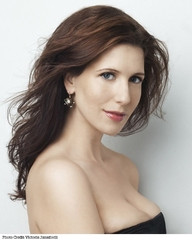|
Back
Avant-Garde Armory Art New York
Park Avenue Armory Board of Officers Room
08/21/2014 -
Dai Fujikura: Minima (New York Premiere)
John Zorn: Baudelaires (New York Premiere)
Alvin Lucier: Chambers
Olivier Messiaen: Chants de terre et de ciel (arranged by Cliff Colmot) (New York Premiere)
Ellie Dehn (Soprano)
International Contemporary Ensemble: David Bowlin, Jennifer Curtis (Violins), Kyle Armbrust, Maiya Papach (Violas), Katinka Klein, Michael Nicolas (Cellos), Dan Lippel (Guitar), Claire Chase (Flutes), Nick Masterson (Oboe), Joshua Rubin (Clarinet), Rebekah Heller (Bassoon), Phyllis Chen, Jacob Greenberg (Pianos), Cory Smythe (Harpsichord), Nathan Davis, Ross Karre (Percussion), Nathan Davis (Hammered Dulcimer), David Fulmer (Conductor)

E. Dehn (© Courtesy of the Artist)
Not even a composer as eclectic as John Zorn could have pigeonholed last night’s concert into a category called “Mostly Mozart.” But those musicians of the International Contemporary Ensemble (ICE) are so deft, adept and just damned good in whatever they do that Amadeus’s spirit would have approved their craft. (And been agreeably amused by their 21st Century art.)
He certainly would have fallen in love with Olivier Messiaen’s six Songs of the Earth and Sky. Even if we mortals wouldn’t quite have recognized it. For the young Messiaen, who wrote his own beautiful poems here, had composed this for soprano and piano. And the piano in the original is so sensitive, such an ideal partner for the singer that one must listen, as to six reverences (with one macabre interlude).
Arranger/conductor Chris Colnot achieved a mastery in his chamber orchestration of the piece. While the piano had a role, Mr. Colnot took away its major partnership. Replacing those eerie high notes was the flute. Replacing the tremolos in the piano was light percussion. Instead of those first hypnotic chords was a flurry, a disguised chorale of winds and strings.
The result was not a replica of the original, but a harder, more emphatic, more dramatic work. That worked unequivocably well in the grotesque “Midnight Heads and Tails For Death”, while his full orchestration for the final “Resurrection” and its repeated “Allelujah” was most convincing.
Yet after the first measures, one forgot completely about Mr. Colnot’s transfiguration. Soprano Ellie Dehn gave a startling performance, one which transcended the composer. Not in the notes, but in the inflection and style, she could have been singing a Mahler song cycle.
She is obviously a soprano, but rarely did her voice go up the register. Instead, in the lullabies, her softness, her middle range was dark and intense. In the strange rhythms from “Dance of Baby Pilule”, she accented the words, which in translation could have come from James Joyce: “Her perpetual yes was a tranquil lake.”
The ending “Resurrection” modified the early love for child and wife into a love of God, and Ms. Dehn, with her effortless rings of “Allelujah” provided the spectacular emotion with Messiaen’s glorious orisons.

J. Zorn (© Coco T. Dog)
John Zorn’s Baudelaires was a different case. Mr. Zorn could be compared to an 18th Century man of all music. Jazz, rock, shtetl klezmer, music for orchestra, for piano. Almost unnervingly, he does it all. Not because a patron or archbishop or Prince demands it, but because he obviously enjoys the challenge, and he has both the chops and the mind to make it work.
Baudelaires was not quite a cryptic title. Mr. Zorn’s jeux de mots probably referred to the song/poems of the French symbolist poet. His music, scored for violin, cellos, two kinds of flute and cello, bassoon, guitar and harpsichord, though odd, was a typical challenge for the composer. On first hearing, though, these sounds seemed to almost make sense.
In ensemble, they produced Zorn’s so careful counterpoint amidst seeming anarchy. Out from these chords came the flute, the violin, the sounds of bass flute and cello. By the second movement, it seemed that Mr. Zorn had tried to create a kind of modern Brandenburg Concerto or at least a concerto grosso, with the harpsichord and bassoon playing the base notes against the sometimes rollicking treble.
What makes this, and other Zorn works so fascinating is that behind the rarely acidic dissonances is the mind of an expert craftsman, putting together these instruments with Baroque care. Baudelaires was (oh, I hate to use this word) “Interesting.” (There, I said it!) I didn’t get it at first hearing, though the colors were startling. And I would love to have a second chance to hear the whole 12-minute work again.
The opening work again featured flute, played by ICE Artistic Director Claire Chase. But into this weaving of flute with other instruments, Dai Fujikura produced a series of sounds for his work Minana.
That title was easier to deduce. He had written a concerto, Mina, inspired by the birth of his child, Mina. This work, rewritten for winds and percussion, was a set of lullabies and wonderments for this child.
The last time I had heard Mr. Fujikura was in Joule, a remarkable piano work filled with energy, pointed polyrhythms, and syncopations leading to advanced jazz. Minima didn’t have that same energy, but the lines were clever, the music often as consonant as it was dissonant.
In a way, Messiaen and Fujikura had much in common. Both works were written out of human love, for wife and daughter. Messiaen was more poetic, Fujikura more conflicted. But both works were consumed with adoration.
Nobody would dare admit it, but the best-loved music of the evening belonged to Alvin Lucier. For many decades, the daring Mr. Lucifer...(er, sorry, Lucier) has played a Satanic role in music. I last heard him in Group Tapper, where four players walked around each other tapping on their instrument.
His Chambers was equally moving–literally. Phyllis Chen with her own design of a music box (either a toy piano mechanism or a toy vibraphone), strolled down the aisle and sat down playing the tintinnabulations. Next up the aisle–casually or solemnly or purposely or with meditation–came other players from ICE, each carrying an object. One had a lobster, another a takeout bag from a Chinese restaurant, another a blue vase, several with boxes... They walked up to the stage, placed their objects, went off stage, came back, picked up their objects and walked off.
Mr. Lucier has composed several Chambers for different sonic spots, and this one was for the Park Avenue Armory room with its three portraits of Ye Olde Military Officers looking disdainfully down from the wall.
Like the final course of a classical Chinese banquet – where the chefs create a dish from the leftovers of the preceding dishes – Chambers was never heard (or seen) before, and will never be seen (or heard) ever again.
A joyous Hail and an obligatory Farewell!
Harry Rolnick
|